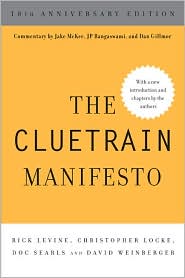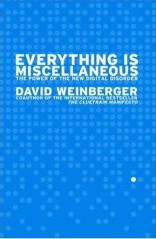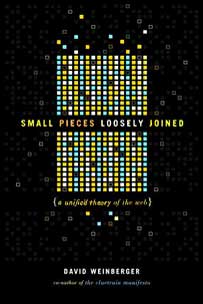October 25, 2017
[liveblog] John Palfrey’s new book (and thoughts on rules vs. models)
John Palfrey is doing a launch event at the Berkman Klein Center for his new book, Safe Spaces, Brave Spaces: Diversity and Free Expression in Education. John is the Head of School at Phillips Academy Andover, and for many years was the executive director of the Berkman Klein Center and the head of the Harvard Law School Library. He’s also the chairman of the board of the Knight Foundation. This event is being put on by the BKC, the Law Library, and Andover. His new book is available on paper, or online as an open access book. (Of course it is. It’s John Palfrey, people!)
[Disclosure: Typical conversations about JP, when he’s not present, attempt — and fail — to articulate his multi-facted awesomeness. I’ll fail at this also, so I’ll just note that JP is directly responsible for my affiliation with the BKC and and for my co-directorship of the Harvard Library Innovation Lab…and those are just the most visible ways in which he has enabled me to flourish as best I can. ]
Also, at the end of this post I have some reflections on rules vs. models, and the implicit vs. explicit.
|
NOTE: Live-blogging. Getting things wrong. Missing points. Omitting key information. Introducing artificial choppiness. Over-emphasizing small matters. Paraphrasing badly. Not running a spellpchecker. Mangling other people’s ideas and words. You are warned, people. |
John begins by framing the book as an attempt to find a balance between diversity and free expression. Too often we have pitted the two against each other, especially in the past few years, he says: the left argues for diversity and the right argues for free expression. It’s important to have both, although he acknowledges that there are extremely hard cases where there is no reconciliation; in those cases we need rules and boundaries. But we are much better off when we can find common ground.
“This may sound old-fashioned in the liberal way. And that’s true,” he says. But we’re having this debate in part because young people have been advancing ideas that we should be listening to. We need to be taking a hard look.
Our institutions should be deeply devoted to diversity, equity and inclusion. Our institutions haven’t been as supportive of these as they should be, although they’re getting better at it, e.g. getting better at acknowledging the effects of institutional racism.
The diversity argument pushes us toward the question of “safe spaces.” Safe spaces are crucial in the same way that every human needs a place where everyone around them supports them and loves them, and where you can say dumb things. We all need zones of comfort, with rules implicit or explicit. It might be a room, a group, a virtual space… E.g., survivors of sexual assault need places where they know there are rules and they can express themselves without feeling at risk.
But, John adds, there should also be spaces where people are uncomfortable, where their beliefs are challenged.
Spaces of both sorts are experienced differently by different people. Privileged people like John experience spaces as safe that others experience as uncomfortable.
The examples in his book include: trigger warnings, safe spaces, the debates over campus symbols, the disinvitation of speakers, etc. These are very hard to navigate and call out for a series of rules or principles. Different schools might approach these differently. E.g.,students from the Gann Academy are here tonight, a local Jewish high school. They well might experience a space differently than students at Andover. Different schools well might need different rules.
Now John turns it over to students for comments. (This is very typical JP: A modest but brilliant intervention and then a generous deferral to the room. I had the privilege of co-teaching a course with him once, and I can attest that he is a brilliant, inspiring teacher. Sorry, but to be such a JP fanboy, but I am at least an evidence-based fanboy.) [I have not captured these student responses adequately, in some cases simply because I had trouble hearing them. They were remarkable, however. And I could not get their names with enough confidence to attempt to reproduce them here. Sorry!]
Student Responses
Student: I graduated from Andover and now I’m at Harvard. I was struck by the book’s idea that we need to get over the dichotomy between diversity and free expression. I want to address Chapter 5, about hate speech. It says each institution ought to assess its own values to come up with its principles about speech and diversity, and those principles ought to be communicated clearly and enforced consistently. But, I believe, we should in fact be debating what the baseline should be for all institutions. We don’t all have full options about what school we’re going to go to, so there ought to be a baseline we all can rely on.
JP: Great critique. Moral relativism is not a good idea. But I don’t think one size fits all. In the hardest cases, there might be sharpest limits. But I do agree there ought to be some sort of baseline around diversity, equity, and inclusion. I’d like to see that be a higher baseline, and we’ve worked on this at Andover. State universities are different. E.g., if a neo-Nazi group wants to demonstrate on a state school campus and they follow the rules laid out in the Skokie case, etc., they should be allowed to demonstrate. If they came to Andover, we’d say no. As a baseline, we might want to change the regulations so that the First Amendment doesn’t apply if the experience is detrimental to the education of the students; that would be a very hard line to draw. Even if we did, we still might want to allow local variations.
Student: Brave spaces are often build from safe spaces. E.g., at Andover we used Facebook to build a safe space for women to talk, in the face of academic competitions where misogyny was too common. This led to creating brave places where open, frank discussion across differences was welcomed.
JP: Yes, giving students a sense of safety so they can be brave is an important point. And, yes, brave spaces do often grow from safe spaces.
Andover student: I was struck by why diversity is important: the cross-pollination of ideas. But from my experience, a lot of that hasn’t occurred because we’re stuck in our own groups. There’s also typically a divide between the students and the faculty. Student activitsts are treated as if they’re just going through a phase. How do we bridge that gap?
JP: How do we encourage more cross-pollination? It’s a really hard problem for educators. I’ve been struck by the difference between teaching at Harvard Law and Andover in terms of the comfort with disagreeing across political divides; it was far more comfortable at the Law School. I’ve told students if you present a paper that disagrees with my point of view and argues for it beautifully, you’ll do better than parroting ideas back to me. Second, we have to stop using demeaning language to talk about student activists. BTW, there is an interesting dynamic, as teachers today may well have been activists when they were young and think of themselves as the reformers.
Student: [hard to hear] At Andover, our classes were seminar-based, which is a luxury not all students have. Also: Wouldn’t encouraging a broader spread of ideas create schisms? How would you create a school identity?
JP: This echoes the first student speaker’s point about establishing a baseline. Not all schools can have 12 students with two teachers in a seminar, as at Andover. We need to find a dialectic. As for schisms: we have to communicate values. Institutions are challenged these days but there is a huge place for them as places that convey values. There needs to be some top down communication of those values. Students can challenge those values, and they should. This gets at the heart of the problem: Do we tolerate the intolerant?
Student: I’m a graduate of Andover and currently at Harvard. My generation has grown up with the Internet. What happens when what is supposed to be a safe space becomes a brave space for some but not all? E.g., a dorm where people speak freely thinking it’s a safe space. What happens when the default values overrides what someone else views as comfortable? What is the power of an institution to develop, monitor, and mold what people actually feel? When communities engage in groupthink, how can an institution construct space safes?
JP: I don’t have an easy answer to this. We do need to remember that these spaces are experienced differently by different people, and the rules ought to reflect this. Some of my best learning came from late night bull sessions. It’s the duty of the institution to do what it can to enable that sort of space. But we also have to recognize that people who have been marginalized react differently. The rule sets need to reflect that fact.
Student: Andover has many different forum spaces available, from hallways to rooms. We get to decide to choose when and where these conversations will occur. For a more traditional public high school where you only have 30-person classroom as a forum, how do we have the difficult conversations that students at Andover choose to have in more intimate settings?
JP: The size and rule-set of the group matters enormously. Even in a traditional HS you can still break a class into groups. The answer is: How do you hack the space?
Student: I’m a freshman at Harvard. Before the era of safe spaces, we’d call them friends: people we can talk with and have no fear that our private words will be made public, and where we will not be judged. Safe spaces may exclude people, e.g., a safe space open only to women.
JP Andover has a group for women of color. That excludes people, and for various reasons we think that’s entirely appropriate an useful.
Q&A
Q [Terry Fisher]: You refer frequently to rule sets. If we wanted to have a discussion in a forum like this, you could announce a set of rules. Or the organizer could announce values, such as: we value respect, or we want people to take the best version of what others say. Or, you could not say anything and model it in your behavior. When you and I went to school, there were no rules in classrooms. It was all done by modeling. But this also meant that gender roles were modeled. My experience of you as a wonderful teacher, JP, is that you model values so well. It doesn’t surprise me that so many of your students talk with the precision and respectfulness that you model. I am worried about relying on rule sets, and doubt their efficacy for the long term. Rather, the best hope is people modeling and conveying better values, as in the old method.
JP: Students, Terry Fischer was my teacher. May answer will be incredibly tentative: It is essential for an institution to convey its values. We do this at Andover. Our values tell us, for example, that we don’t want gender-based balance and are aware that we are in a misogynist culture, and thus need reasonable rules. But, yes, modeling is the most powerful.
Q [Dorothy Zinberg]: I’ve been at Harvard for about 70 yrs and I have seen the importance of an individual in changing an institution. For example, McGeorge Bundy thought he should bring 12 faculty to Harvard from non-traditional backgrounds, including Erik Erikson who did not have a college degree. He had been a disciple of Freud’s. He taught a course at Harvard called “The Lifecycle.” Every Harvard senior was reading The Catcher in the Rye. Erikson was giving brilliant lectures, but I told him it was from his point of view as a man, and had nothing to do with the young women. So, he told me, a grad student, to write the lectures. No traditional professor would have done that. Also: for forming groups, there’s nothing like closing the door. People need to be able to let go and try a lot of ideas.
Q: I am from the Sudan. How do you create a safe space in environments that are exclusive. [I may have gotten that wrong. Sorry.] How do you acknowledge the native American tribes whose land this institution is built on, or the slaves who did the building?
JP: We all have that obligation. [JP gives some examples of the Law School recently acknowledging the slave labor, and the money from slave holders, that helped build the school.]
Q: You used a kitchen as an example of a safe space. Great example. But kitchens are not established or protected by any authority. It’s a new idea that institutions ought to set these up. Do you think there should be safe spaces that are privately set up as well as by institutions? Should some be permitted to exclude people or not?
(JP asks a student to respond): Institutional support can be very helpful when you have a diversity of students. Can institutional safe spaces supplement private ones? I’m not sure. And I do think exclusive groups have a place. As a consensus forms, it’s important to allow the marginalized voices to connect.
Q [ head of Gann]: I’m a grad of Phillips Academy. As head of a religious school, we’re struggling with all these questions. Navigating these spaces isn’t just a political or intellectual activity. It is a work of the heart. If the institution thinks of this only as a rational activity and doesn’t tend to the hearts of our students, and is not explicit about the habits of heart we need to navigate these sensitive waters, only those with natural emotional skills will be able to flourish. We need to develop leaders who can turn hard conversations into generative ones. What would it look like to take on the work of developing social and emotional development?
JP: Ive been to Gann and am confident that’s what you’re doing. And you can see evidence of Andover’s work on it in the students who spoke tonight. Someone asked me if a student became a Nazi, would you expel him? Yes, if it were apparent in his actions, but probably not for his thoughts. Ideally, our students won’t come to have those views because of the social and emotional skills they’re learning. But people in our culture do have those views. Your question brings it back to the project of education and of democracy.
[This session was so JP!]
A couple of reactions to this discussion without having yet read the book.
First, about Prof. Fisher’s comment: I think we are all likely to agree that modeling the behavior we want is the most powerful educational tool. JP and Prof. Fisher, are both superb, well, models of this.
But, as Prof. Fisher noted in his question, the dominant model of discourse for our generation silently (and sometimes explicitly) favored males, white middle class values, etc. Explicit rules weren’t as necessary because we had internalized them and had stacked the deck against those who were marginalized by them. Now that diversity has thankfully become an explicit goal, and now that the Internet has thrown us into conversations across differences, we almost always need to make those rules explicit; a conversation among people from across divides of culture, economics, power, etc. that does not explicitly acknowledge the different norms under which the participants operate is almost certainly going to either fragment or end in misunderstanding.
(Clay Shirky and I had a collegial difference of opinion about this about fifteen years ago. Clay argued for online social groups having explicit constitutions. I argued
for the importance of the “unspoken” in groups, and the damage that making norms explicit can cause.)
Second, about the need for setting a baseline: I’m curious to see what JP’s book says about this, because the evidence is that we as a culture cannot agree about what the baseline is: vociferous and often nasty arguments about this have been going on for decades. For example, what’s the baseline for inviting (or disinviting) people with highly noxious views to a private college campus? I don’t see a practical way forward for establishing a baseline answer. We can’t even get Texas schools to stop teaching Creationism.
So, having said that modeling is not enough, and having despaired at establishing a baseline, I think I am left being unhelpfully dialectical:
1. Modeling is essential but not enough.
2. We ought to be appropriately explicit about rules in order to create places where people feel safe enough to be frank and honest…
3. …But we are not going to be able to agree on a meaningful baseline for the U.S., much less internationally — “meaningful” meaning that it is specific enough that it can be applied to difficult cases.
4. But modeling may be the only way we can get to enough agreement that we can set a baseline. We can’t do it by rules because we don’t have enough unspoken agreement about what those rules should be. We can only get to that agreement by seeing our leading voices in every field engage across differences in respectful and emotionally truthful ways. So at the largest level, I find I do agree with Prof. Fisher: we need models.
5. But if our national models are to reflect the values we want as a baseline, we need to be thoughtful, reflective, and explicit about which leading voices we want to elevate as models. We tend to do this not by looking for rules but by looking for Prof. Fisher’s second alternative: values. For example, we say positively that we love John McCain’s being a “maverick” or Kamala Harris’ careful noting of the evidence for her claims, and we disdain Trump’s name-calling. Rules derive from values such as those. Values come before rules.
I just wish I had more hope about the direction we’re going in…although I do see hopeful signs in some of the model voices who are emerging, and most of all, in the younger generation’s embrace of difference.








